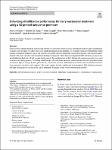Thông tin tài liệu
Thông tin siêu dữ liệu biểu ghi
| Trường DC | Giá trị | Ngôn ngữ |
|---|---|---|
| dc.contributor.author | Al-Tayawi, Aws N. | - |
| dc.contributor.author | Gulyás, Nikolett Sz. | - |
| dc.contributor.author | Gergely, Gréta | - |
| dc.date.accessioned | 2023-10-03T08:45:30Z | - |
| dc.date.available | 2023-10-03T08:45:30Z | - |
| dc.date.issued | 2023 | - |
| dc.identifier.uri | https://link.springer.com/article/10.1007/s11356-023-30027-4 | - |
| dc.identifier.uri | https://dlib.phenikaa-uni.edu.vn/handle/PNK/9435 | - |
| dc.description | CC-BY | vi |
| dc.description.abstract | Dairy factories annually generate an increasing amount of wastewater, which can cause eutrophication due to high concentrations of amino acids and lipids. To address this issue, membrane technology has emerged as a promising solution, but membrane fouling remains a significant challenge, since it can cause decreased flux, decrease membrane rejection performance, and increased energy demand. This study aimed to reduce membrane fouling by integrated a three-dimensional printed (3DP) turbulence promoter into an ultrafiltration dead-end cell and varying stirring speeds. Two mathematical models, Hermia and resistance-in-series, were used to analyze the fouling process. According to both models, the cake layer formation model indicated the most prevalent fouling mechanism. Specific energy demand, permeate flux, membrane rejection, and membrane reversible and irreversible resistances were measured, calculated, and compared. | vi |
| dc.language.iso | en | vi |
| dc.publisher | Springer | vi |
| dc.subject | ultrafiltration performance | vi |
| dc.subject | 3D printed turbulence promoter | vi |
| dc.title | Enhancing ultrafiltration performance for dairy wastewater treatment using a 3D printed turbulence promoter | vi |
| dc.type | Book | vi |
| Bộ sưu tập | ||
| OER - Khoa học môi trường | ||
Danh sách tệp tin đính kèm:

